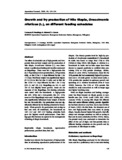Growth and fry production of Nile tilapia, Oreochromis niloticus (L.), on different feeding schedules
Share
Abstract
The effect of scheduled use of high-protein and low-protein diets on body weight and fry production of Nile tilapia, Oreochromis niloticus (L.), was determined. A preliminary feeding trial was first conducted on fingerlings. These were fed a high-protein diet (H, 25% protein) or a low-protein diet (L, 18% protein) daily, or diet H for 1–3 days followed by diet L for 1–4 days. Final body weight was significantly higher (P < 0.05) in fish fed diet H daily and in fish fed diet H for 2–3 days followed by diet L for 1 day (2H−1L and 3H−1L). Fingerlings on 1H−1L and 3H−2L had slightly lower growth. Based on the response of the fingerlings, five feeding schedules were tested with the broodstock. A high-protein diet (HP, 40%) and a low-protein diet (LP, 25%; same as H for fingerlings) were used. Feeding schedules significantly influenced body weight of female but not the male fish. Fry production was not significantly affected by the feeding schedule for broodstock. When growth, fry production and saving in feed cost were all considered, the broodstock on 1HP−1LP and 3HP−2LP feeding schedules both gave the highest overall performance. These findings give fish farmers an option in the management of feeding of tilapia broodstock.
Suggested Citation
Santiago, C. B., & Laron, M. A. (2002). Growth and fry production of Nile tilapia, Oreochromis niloticus (L.), on different feeding schedules. Aquaculture Research , 33(2), 129-136. https://doi.org/10.1046/j.1365-2109.2002.00664.x
Subject
Collections
- AQD Journal Articles [1249]

